介绍
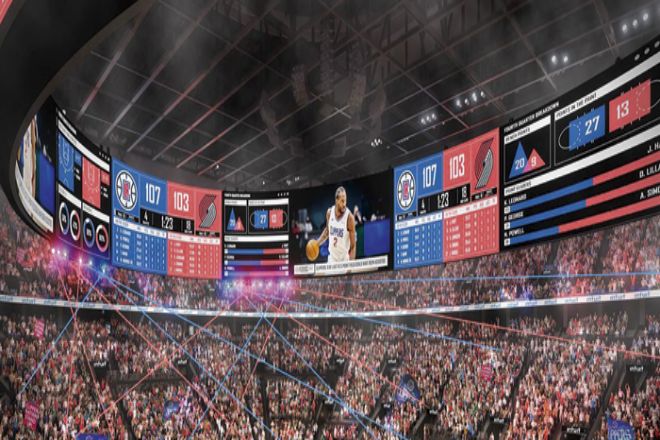
柔性LED显示屏, 作为现代材料科学与光电子技术的结晶,它不仅打破了传统显示屏的刚性限制,还以其轻巧、可弯曲、高清等特点给体育场馆的视觉效果带来了质的飞跃。
它不仅可以根据场馆的复杂结构灵活安装,形成令人惊叹的弧形或环绕屏,还能实时呈现比赛的高清画面、精彩瞬间、详细的数据统计,大大增强了观众的沉浸感和参与感。
本文将深入探讨柔性LED显示屏在体育场馆的应用,一起来看看。
1、体育场馆柔性LED显示屏的优势
1). 提升观看体验
1.1).灵活安装,组成无缝弧形或环绕屏:
柔性LED显示屏以其独特的可弯曲、可卷曲的特性,能够完美适应各种复杂的场馆结构和弧形设计。
在体育场馆中,这意味着可以根据看台形状、天花板高度或场地边缘定制安装方案,以形成无缝曲面屏或360度环绕屏。
这样的设计不仅打破了传统平面屏幕的限制,还大大提升了视觉沉浸感和立体感,让观众仿佛身临其境,无论是观看现场直播、慢动作回放,还是实时数据统计,都能获得更加震撼逼真的视觉体验。
1.2).增强观众的沉浸感和参与感:
通过高清画质、高 刷新率、广色域,柔性LED显示屏可以精准还原比赛场景的每一个细节,包括球员的每一个动作,球速的轨迹变化等,让观众感受到前所未有的真实感和参与感。
同时结合场馆内的音响系统以及AR增强现实等互动技术,可以进一步丰富观赛体验,让观众仿佛与赛事融为一体。
2).增强场地的多功能性
2.1). 易于拆卸和重新组装,适应各种活动的需求:
柔性LED显示屏的另一显著优势是其高度的灵活性和可重构性,相比传统硬性显示屏,柔性LED显示屏重量更轻,安装拆卸更加方便,可根据不同活动的需求,快速调整布局和尺寸。
这使得体育场能够轻松实现从 运动的 活动、音乐会, 展览、等活动,大大提高了场馆的利用率和经济效益。
2.2). 灵活性作为临时措施 阶段 背景、广告牌等:
除了体育赛事之外,柔性LED显示屏还可作为临时舞台背景、广告牌等,为赛事增添更多创意和亮点。
其多样化的展示内容、灵活的展示方式能够吸引更多观众的注意力和兴趣,为赞助商和主办方创造更多的商业价值和宣传机会。
3).节能环保、节省成本
3.1).能效比高、使用寿命长:
柔性LED显示屏在节能方面表现出色,发光效率高,能耗低。
这意味着在长期运行下,它的耗电量远低于传统显示屏,有助于降低场馆运营成本,并减少对环境的影响。
同时柔性LED显示屏还具有较长的使用寿命和稳定的性能,能够长时间保持优质的显示效果和可靠性。
3.2). 维护成本低:
柔性LED显示屏虽然前期投入可能相对较高,但从长远来看其维护成本相对较低,这主要得益于其先进的制造工艺和优质的材料选用,使得显示屏在长期使用过程中不易出现故障和损坏。
此外,柔性LED显示屏还具有较高的自我修复能力,可以在一定程度上减轻维护工作的负担和成本。
3.3). 长期运行成本效益:
考虑到柔性LED显示屏在提升观看体验、增强场馆通用性、节能环保等方面的优势,可以得出其在长期运行中的成本效益非常显著。
虽然前期投入较大,但随着时间的推移和场馆利用率的提高,其带来的经济效益和社会效益将逐渐显现并超越传统显示屏。因此对于追求高质量可持续发展的场馆来说,柔性LED显示屏无疑是一个值得考虑的优先选择。
2、体育场馆柔性LED显示屏一般安装在什么位置?
体育场馆柔性LED显示屏的安装位置通常取决于多种因素,包括场馆结构、观众观看角度、活动需求、预算等。以下是一些常见的安装位置:
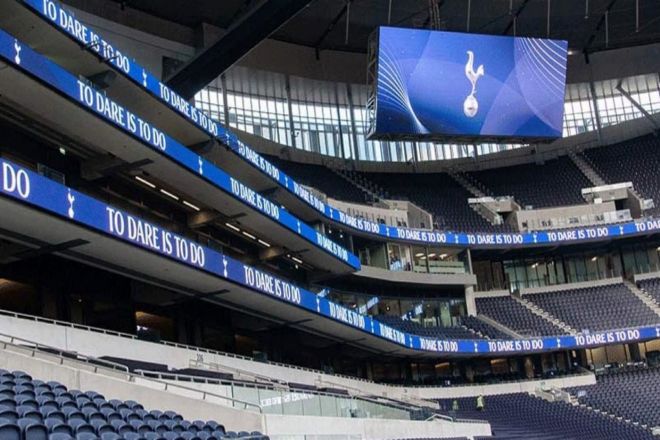
1). 礼堂周围:
柔性LED显示屏可安装在观众席上方或侧面,形成环绕式或弧形屏幕,为观众提供身临其境的观看体验。这种安装方式可以增强视觉冲击力,让观众仿佛置身于比赛现场。
- 中心会场:
对于一些需要突出中心场地表现的体育赛事或活动,比如篮球、足球等,可以在场地中央上方安装柔性LED显示屏,作为比赛计时、比分显示,或广告展示的屏幕。
这种安装方式要求显示屏有较高的稳定性和承重能力。
2). 场地边缘:
场馆边缘也是柔性LED显示屏常见的安装位置之一,通过将屏幕安装在场馆边缘,可以实时显示比赛信息、运动员数据等,为观众提供更全面的赛事信息。
同时,这种安装方式也有助于提升场馆的整体视觉效果和观看体验。
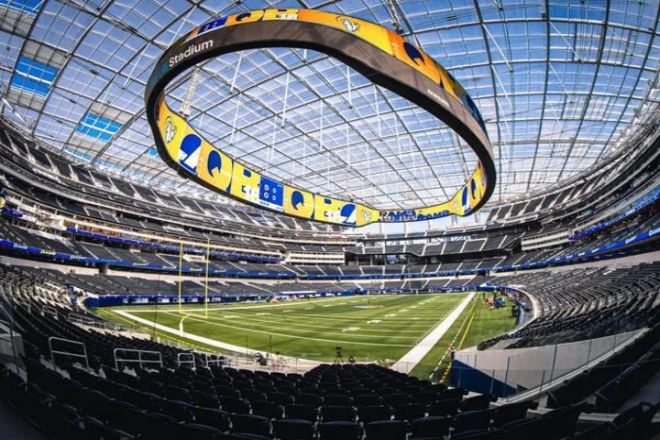
3). 多功能区:
体育场馆通常具有多个多功能区域,例如舞台、休息区等,在这些区域,柔性LED显示屏可以作为临时的舞台背景、广告牌,或者信息显示屏。
柔性LED显示屏由于其易于拆卸和重组的特点,可以根据不同活动的需要进行灵活调整。
需要注意的是,柔性LED显示屏的安装位置要充分考虑观众的观看角度和视线高度,保证观众能清晰的看到屏幕上的内容。
同时,在安装过程中还需要考虑显示屏的稳定性、承重能力、安全性等因素,确保长期使用过程中不出现安全隐患。
3、柔性LED显示屏在体育场馆的应用实例
在体育场馆中,柔性LED显示屏的应用越来越广泛,给观众带来了全新的观看体验。
下面就国内外体育场馆中几个具有代表性的柔性LED显示屏应用实例进行分析:
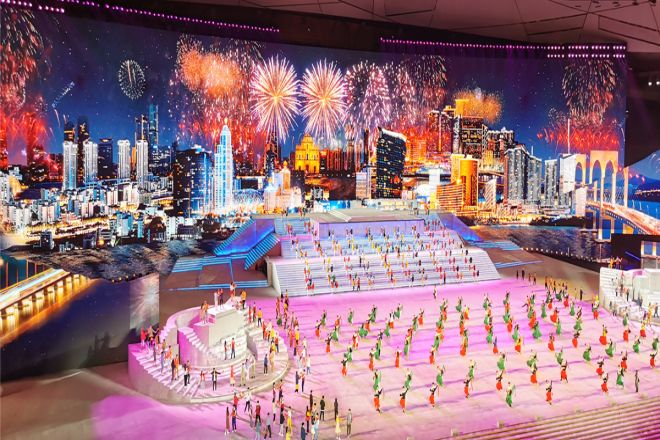
1). 北京冬奥会场馆
- 开幕式和闭幕式:
北京冬奥会开幕式上,约11000平方米的地面显示屏、1200平方米的冰瀑布屏、600平方米的冰块屏、1000平方米的看台屏,共同组成了世界一流的LED显示系统。
虽然目前没有明确提到是否采用柔性LED显示屏,但考虑到柔性屏的灵活性和创造性,可能会在一些特殊造型或者弧形结构上运用。
这些显示屏构建起一个立体的舞台,给观众呈现一场无与伦比的视听盛宴。
五棵松冰上运动中心:
洲明科技为五棵松冰上运动中心提供大屏幕高清显示,助力打造LED计时计分显示系统。
虽然这些屏幕可能主要是刚性 LED 屏幕,但柔性 LED 显示屏的灵活性和创造性也是在设计类似项目时值得考虑的选择。
成功:
设计创意:采用LED显示屏构建的立体舞台、丰富的视觉效果,充分展现了科技与美学的结合,为冬奥会增添了独特的魅力。
技术实现:通过高精度的LED显示技术及创新的安装方案,保证显示屏的稳定性和显示效果,为观众提供优质的观看体验。
观众反馈:观众普遍对开幕式和赛事现场的视觉效果表示赞赏,认为这些创新设计增强了比赛的观赏性和沉浸感。
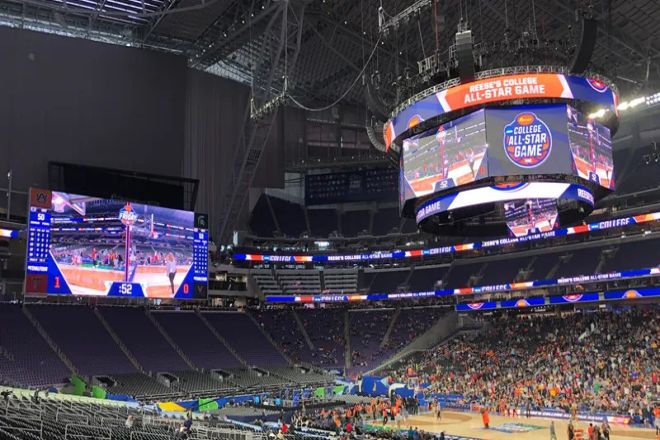
2). 美国NBA球场
- NBA全明星赛LED球场:
2024年NBA全明星赛将在全新的LED球场上举行,这是柔性LED显示屏在体育场馆应用的典型例子。
作为比赛场地,LED屏幕不仅能显示出图案变化、色彩变幻等视觉效果,还融入了实时数据统计、选手位置追踪动画等功能,给观众带来前所未有的视觉体验。
- 斯台普斯中心,NBA湖人队主场:
该场馆采用由锐拓设计、生产、安装的吊顶屏系统,包括顶部和底部无缝过渡的弧形屏和主屏中央的高清屏幕。
这些屏幕通过提高对比度和亮度,并采用超高清三合一黑壳表贴技术,达到了“最黑最亮”的显示效果,为观众提供了更加清晰的观看体验。
成功:
- 设计创意:
LED球场的设计打破了传统篮球场的界限,将科技与体育完美结合,给观众带来全新的观看体验。
斯台普斯中心的吊顶屏幕系统也通过创新的设计和先进的技术实现了出色的显示效果。
- 技术实现:
LED球场屏及吊顶屏系统均采用先进的技术和制造工艺,保证了显示的稳定性和高清晰度。
同时通过智能控制系统实现各种复杂的视觉效果和交互功能。
- 观众反馈:
观众对LED球场及吊顶屏幕系统反应非常积极,认为这些创新设计大大增强了比赛的观赏性和娱乐性。
他们表示,在观看过程中感受到了前所未有的沉浸感和参与感。
4.体育场馆柔性LED屏面临的挑战
1). 成本控制
柔性LED屏幕采用柔性材料作为基板,其价格往往比传统的刚性材料更高。
此外,为了保证屏幕的柔韧性和耐用性,还需要更高级别的封装材料和工艺,进一步增加了成本。
- 制造和维护:
柔性LED屏的制造工艺更加复杂,需要的设备更加精密,技术水平更高,这也会导致制造成本的增加。
同时由于其结构的特殊性,后期的维护和更换也可能比传统屏幕更加复杂和昂贵。
2). 散热管理
柔性LED屏在运行过程中会产生大量的热量,如果散热不良,不仅会影响屏体的性能和寿命,还可能造成安全隐患。
由于其灵活的特性,风扇散热等传统散热方式可能并不适用,需要液球封装技术、热管技术等更高效的散热设计。
- 结构设计:
在体育场馆等大型应用场景中,如何合理设计散热结构,保证热量能够快速散发,是柔性LED屏面临的重要技术难题。
3)大规模定制
体育场馆对于显示屏的尺寸、形状、安装方式等往往有特殊的要求,这就需要柔性LED显示屏具备大规模定制的能力。
但这种定制化需求对设计和制造都提出了更高的要求,需要企业具备强大的研发和生产能力。
- 成本与效率:
在大规模定制的过程中,如何平衡成本和效率,保证在满足客户需求的同时,不会过度增加成本和时间投入,是柔性LED显示屏企业需要面对的问题。
4). 市场接受度
目前,柔性LED显示屏在体育场馆等高端应用场景的认知度还较低。
很多用户对其性能和优势还没有足够的了解,在一定程度上限制了其市场的推广和应用。
为了提高市场认知度,柔性LED显示屏企业需加强产品宣传推广力度,通过案例陈述、技术交流等方式,提高用户对产品的了解和认知。
5.BIBILED推荐技术:
BIBILED柔性LED显示屏
推荐理由:
- 适应复杂环境:
柔性LED显示屏采用柔性材料,可以进行弯曲、折叠甚至卷曲,大大提高了安装的灵活性。
这一特点使其能够适应各种不规则的安装环境,如弧形墙面、圆柱体等,为广告、展示等提供更多的创意空间。
- 多种安装方式:
柔性LED显示屏支持落地式、壁挂式、嵌入式、吊挂式等多种安装方式,安装受地域限制较少,可广泛应用于各种场合。
- 响应速度快:
柔性LED显示屏具有极快的响应速度,完全适合体育市场的快节奏。
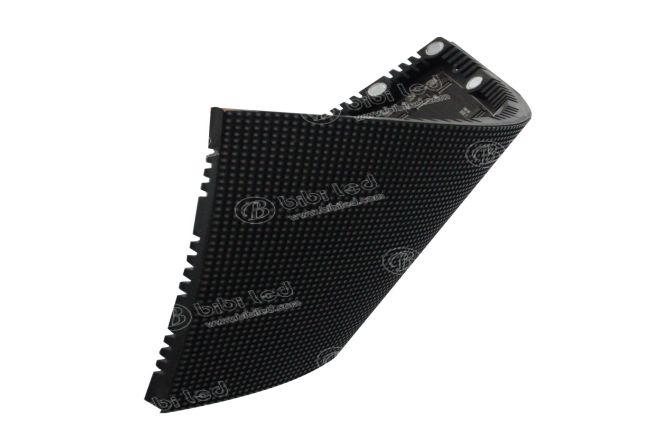
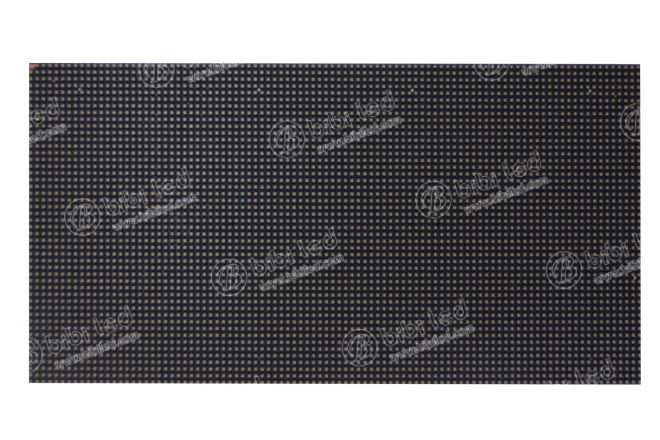
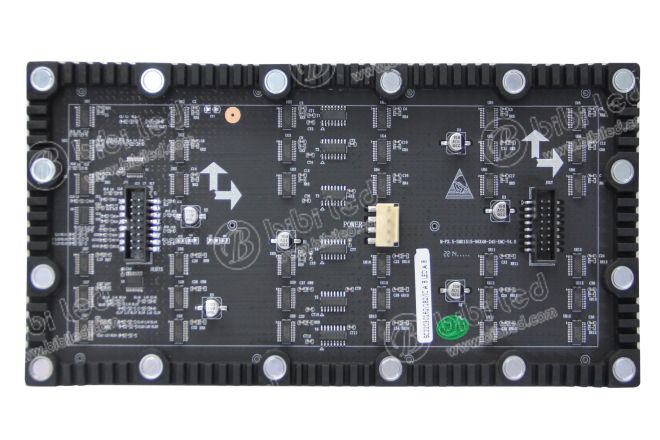
结论
综上所述,柔性LED显示屏作为体育场馆的新宠,不仅凭借着优异的技术性能和广阔的应用前景赢得了市场的青睐,更以其对观赛体验的深刻改变、对体育产业发展的积极推动,成为了科技与体育完美结合的典范。
在未来的日子里,我们有理由相信,随着技术的不断成熟和市场的不断扩大,柔性LED显示屏将在更多的领域展现出其独特的魅力和无限的可能性。
最后,如果你想了解更多关于LED显示屏的信息, 请与我们联系。
